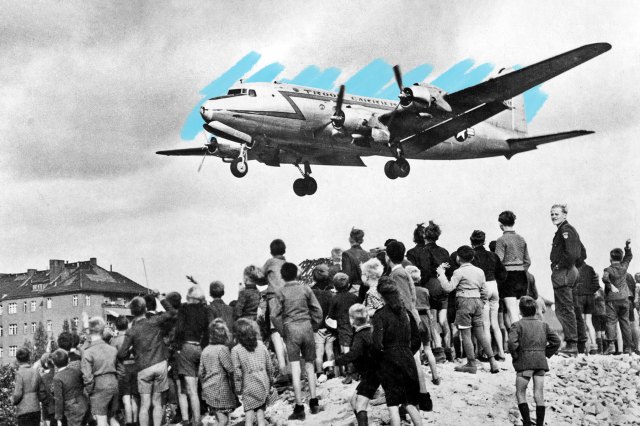 |
At the height of the Berlin Airlift, a plane landed in Berlin every 30 seconds. |
U.S. History |
 |
| |
| Two days later, the United States and Britain initiated a counterblockade to prevent rail traffic from reaching East Berlin. They also found a way around the roadblocks: They took to the skies. So began the Berlin Airlift, also known as Operation Vittles, a 15-month air campaign to deliver food, fuel, and other supplies to West Berlin. Over the course of the operation, pilots and their crews made more than 270,000 air drops to the city. At the height of the airlift in the spring of 1949, an Allied supply plane landed in West Berlin an average of every 30 seconds. The Berlin Airlift was so successful that Soviet Premier Joseph Stalin lifted the blockade in May 1949, realizing the Western Allies could continue their supply missions indefinitely. The operation is now considered the largest humanitarian airlift mission in history. | |
 | |
 | |||||||||
By the Numbers | |||||||||
| |||||||||
| |||||||||
 | |||||||||
| |||||||||
Air traffic control was instrumental to the Berlin Airlift. | |||||||||
| During the Berlin Airlift, the greatest danger to pilots was the sheer amount of air traffic on the approach to Berlin. Landing planes in short intervals increased the potential for disaster on the tarmac, and the majority of casualties during the operation were due to accidents. The issue reached critical mass on a day that flight crews dubbed "Black Friday," when a three-aircraft crash was narrowly avoided. In response, the commander of the airlift instituted new protocols to improve runway safety. Pilots were required to follow the direction of air traffic controllers on the ground, who used radar and other tools to ensure planes could safely take off and land 24 hours a day, and in almost any kind of weather. The new guidelines immediately reduced the potential for accidents, increasing the number of daily flights into Berlin. | |||||||||
 | |||
Recommended Reading | |||
 | |||
| | |||
 | |||
| | |||
| + Load more | |||
| |||||||||
| 700 N Colorado Blvd, #513, Denver, CO 80206 | |||||||||
|







0 comments:
Post a Comment